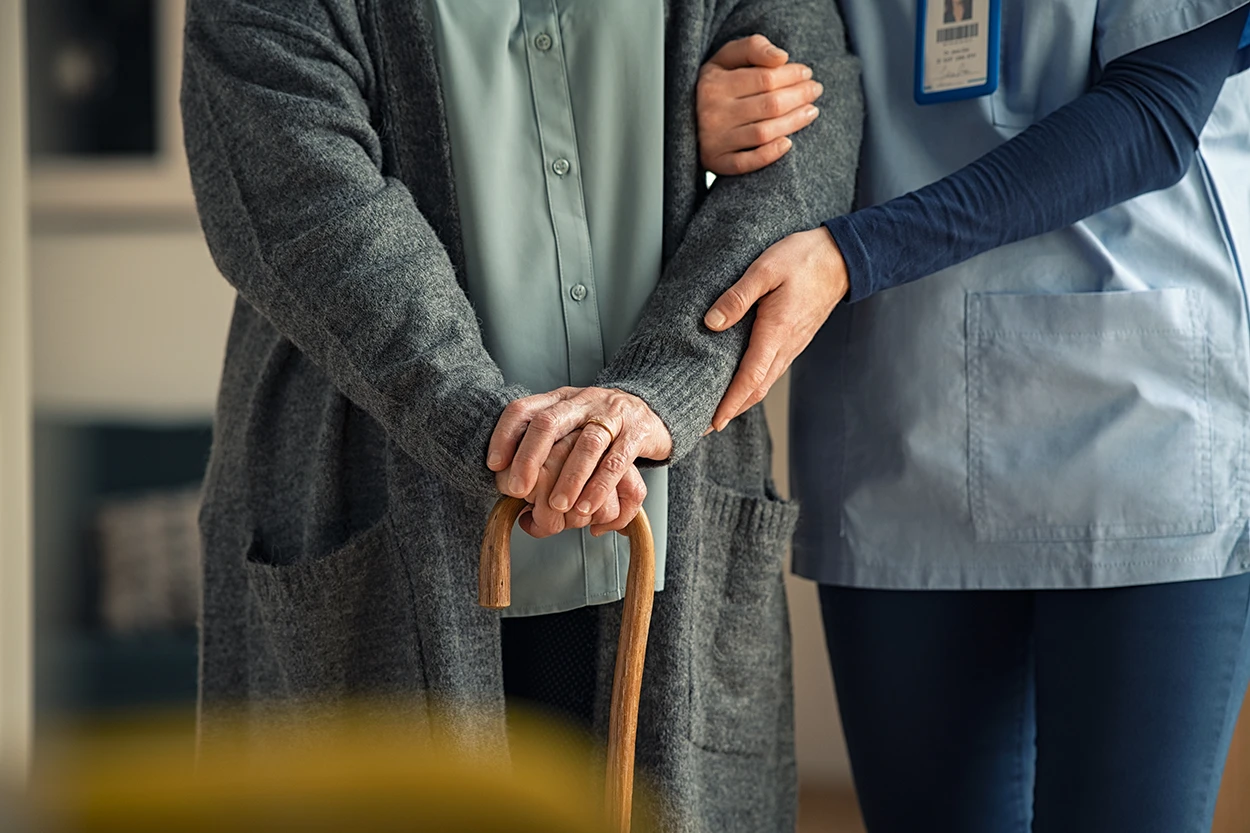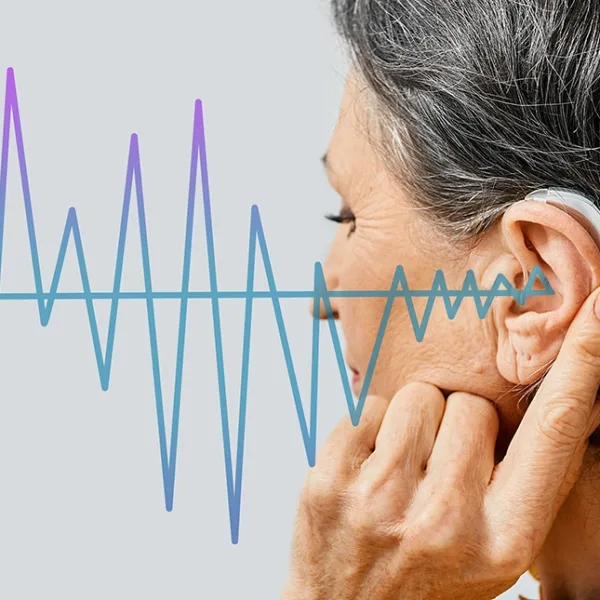
As we get older, it’s common to experience changes in our hearing. You might find yourself turning up the volume on the TV a little louder or asking people to repeat themselves more often. But what many people don’t realize is that hearing loss can also increase your risk of falls for older adults. In fact, even mild degrees of hearing loss can triple your risk of falling.1
In this article, we explain how untreated hearing loss can cause falls and how hearing aids can help support a safe, independent, and active lifestyle.
How Hearing Influences Balance
You might not think your ears have anything to do with balance, but hearing actually plays a big role in helping you stay steady on your feet. This is thanks to two essential systems inside the inner ear: your auditory system (cochlea) and the vestibular system.
Vestibular System
While the cochlea helps you hear by sending signals to your brain about sounds, the vestibular system sends signals about movement and position.
The vestibular system helps with:
- Balance: Detects head movements and positions, allowing you to maintain steady balance while standing, walking, or moving
- Spatial awareness: Helps your brain understand your body’s position and movement in space
- Coordination: Works with other sensory inputs to coordinate body posture and keep your movements smooth and controlled
- Eye stability: Helps stabilize your vision when your head moves by automatically focusing your eyes
The vestibular system and auditory system are interconnected. Both are in the inner ear and share nerve pathways that send information to the brain. Problems in one system can sometimes affect the other.
So, when something affects your hearing, your vestibular system and balance might be affected too. But why does this happen? Let’s break it down below.
How Hearing Loss Increases Fall Risk

Falls are one of the leading causes of injury among older adults, and staying steady on your feet is key to maintaining independence. According to the CDC, over 1 in 4 Americans over the age of 65 fall every year.2
Falls are also the most common cause of traumatic brain injuries, hip fractures, and other serious health concerns. In fact, they contribute to over 3 million emergency room visits each year.3
There’s no denying how serious and frightening falls can be, and preventing them begins with understanding what causes them. One of the most significant risk factors of falls in older adults is hearing loss. The sections below examine why.
Impaired Balance
As we covered above, your inner ear has two important parts: the cochlea, which helps you hear, and the vestibular system, which helps with movement and balance. These two systems sit right next to each other and share some of the same nerve pathways to send signals to the brain.
Because they’re so closely connected, damage to one system often affects the other. That means hearing loss can also signal trouble with balance. In fact, one study found that 22% of participants with hearing loss also experienced dizziness (vertigo).4
However, even if you don’t feel dizzy, your brain may not be getting the right signals to keep you steady, making it easier to lose your balance or trip unexpectedly.
Reduced Environmental Awareness
Sound is essential for helping us stay aware of our surroundings. Noises like approaching footsteps, traffic sounds, and even leaves rustling all help your brain map out the environment. Without this auditory information, it’s easier to misjudge a situation or get caught off guard, which can lead to slips, trips, and falls.
Hearing loss can also cause you to miss important safety signals like shouts, traffic, or alarms. This can put you in dangerous situations that make you susceptible to falling and other injuries.
Increased Cognitive Load
Scientific studies have found a strong link between hearing loss and cognitive decline.5 When your brain is working extra hard to understand speech and fill in the blanks for missed words, it has less cognitive energy left to focus on other things.
This mental overload, known as cognitive load, can impair attention, reaction time, and decision-making skills, which are essential for staying sharp and steady on your feet. Even small deficits in cognitive function can increase the risk of falls.6
Decreased Physical Activity
Research shows a strong link between hearing loss and a decrease in physical activity.7 It’s common for people with untreated hearing loss to start avoiding social events, group activities, or going to noisy places in general, simply because it’s harder to communicate.
Changes in behavior like this can naturally lead to a less active lifestyle. Less physical movement means weaker muscles. Inactivity and muscle disuse can significantly increase the risk of falls.8 This is especially detrimental for older adults who may already be experiencing age-related muscle loss.
Vestibular Disorders
Vestibular disorders are underlying health conditions that cause vestibular dysfunction—disruptions in your balance and spatial orientation. Many different conditions can contribute to both vestibular dysfunction and hearing loss, including:
- Ménière’s disease
- Multiple sclerosis (MS)
- Vestibular neuritis
- Labyrinthitis
- Benign paroxysmal positional vertigo (BPPV)
- Acoustic neuromas (tumors)
- Lyme disease (borreliosis)
- Autoimmune inner ear disease (AIED)
Many of these disorders can cause vision changes, dizziness, vertigo, or a feeling of being off-balance, all of which greatly increase the risk of falling. If you are experiencing any of these symptoms, it’s important to consult a healthcare provider immediately.
How Hearing Loss Treatment Can Help Reduce the Risk of Falls

Hearing loss treatment can not only help with communication, but it can also help you stay steady on your feet. In fact, studies show that for older adults with hearing loss, hearing aids can reduce the risk of falls by up to 50%.9
Below are just a few examples of how hearing loss treatment can reduce fall risk and improve daily quality of life.
Improved Spatial Awareness
Hearing aids help you pick up on important environmental sounds like footsteps, traffic, doorbells, or even someone calling your name. These audio cues help you stay alert and aware of what’s happening around you, reducing the chances of being caught off guard.
This added spatial awareness also helps your brain understand your body’s position and movement in space, helping you feel steady on your feet.
Reduced Cognitive Strain
When you can hear clearly, your brain doesn’t have to work as hard to follow along during conversations or fill in the gaps of missed words caused by hearing loss. This frees up more cognitive resources to focus on things like walking, staying balanced, and reacting to your environment, which is especially important in busy or unfamiliar places.
In-App Balance Tests
Many hearing aids today are compatible with smartphone apps that allow you to adjust your settings, and some even let you test your balance. The My Audibel Hearing Aid App features an easy-to-follow balance assessment exercise that helps you test how steady you are on your feet, right from your phone.
This quick, self-guided test can help you catch early signs of balance issues, track changes over time, and even share results with your healthcare provider. It’s an easy and convenient way to stay proactive about your safety, all with the help of the technology you’re already using to hear better.
Fitness Tracking Features
Did you know that some prescription hearing aids can also double as a fitness tracker? Audibel hearing devices have built-in sensors that can monitor your daily activity levels, counting key metrics like steps, time standing, engagement, and more.
This can be a powerful motivator for encouraging physical activity, supporting improved strength, and lower the risk of falling. In fact, one study involving older adults found that 45% of participants reported increased motivation and 46% implemented healthier lifestyle choices after using fitness trackers for six weeks.10
Hearing aids with this kind of built-in support go beyond better hearing, offering a more complete approach to staying healthy, active, and independent.
Built-In Fall Detection and Alerts
While fitness tracking is amazing, hearing aids with fall detection can be lifesaving. Using the same built-in sensors that track your daily steps, these advanced hearing aids can also monitor body movement and orientation. If a sudden change is detected that is consistent with a fall, it can trigger an automatic alert to be sent to your chosen emergency contacts.
This feature is especially helpful for older adults who are active, live alone, or have a history of falls. By combining hearing support with real-time safety features, these hearing aids act as both a communication tool and a safety device.
Stay Steady, Active, and Independent—Get Your Hearing Checked Today
Hearing loss may seem like a minor inconvenience at first, but it can have a much bigger impact on your health and safety than many people realize. From balance problems to cognitive strain, untreated hearing loss can greatly increase your risk of falling and decrease your overall quality of life.
The good news is that there’s something you can do about it. By taking steps to treat hearing loss, you can reduce your risk of falls and stay safe, steady, and independent.
The hearing care specialists at Audibel are here to help. If you’ve noticed any changes in your hearing, don’t wait—find an Audibel hearing clinic near you today and take a proactive step toward better overall wellness.
References
- Lin, F. R., & Ferrucci, L. (2012b). Hearing loss and falls among older adults in the United States. Archives of Internal Medicine, 172(4), 369. https://doi.org/10.1001/archinternmed.2011.728
- Bergen, G., Stevens, M. R., & Burns, E. R. (2016). Falls and fall injuries among adults aged ≥65 years — United States, 2014. MMWR Morbidity and Mortality Weekly Report, 65(37), 993–998. https://doi.org/10.15585/mmwr.mm6537a2
- Facts about falls. (2024, May 9). Older Adult Fall Prevention. https://www.cdc.gov/falls/data-research/facts-stats/
- Sunitha, M., Asokan, L., & Sambandan, A. P. (2018). Vertigo: Incidences, Diagnosis and Its Relations with Hearing Loss. Indian Journal of Otolaryngology and Head & Neck Surgery, 71(S2), 1282–1286. https://doi.org/10.1007/s12070-018-1315-6
- Wang, H., Zhang, W., Rolls, E. T., Li, Y., Wang, L., Ma, Y., Kang, J., Feng, J., Yu, J., & Cheng, W. (n.d.). Hearing impairment is associated with cognitive decline, brain atrophy and tau pathology. EBioMedicine, 86, 104336. https://doi.org/10.1016/j.ebiom.2022.104336
- Trevisan, C., Ripamonti, E., Grande, G., Triolo, F., Ek, S., Maggi, S., Sergi, G., Fratiglioni, L., & Welmer, A. (n.d.). The Association Between Injurious Falls and Older Adults’ Cognitive Function: The Role of Depressive Mood and Physical Performance. The Journals of Gerontology Series A, 76(9), 1699–1706. https://doi.org/10.1093/gerona/glab061
- Kuo, P., Di, J., Ferrucci, L., & Lin, F. R. (2021). Analysis of hearing loss and physical activity among US adults aged 60-69 years. JAMA Network Open, 4(4), e215484. https://doi.org/10.1001/jamanetworkopen.2021.5484
- McKendry, J., Coletta, G., Nunes, E. A., Lim, C., & Phillips, S. M. (2024). Mitigating disuse‐induced skeletal muscle atrophy in ageing: Resistance exercise as a critical countermeasure. Experimental Physiology, 109(10), 1650–1662. https://doi.org/10.1113/ep091937
- Campos, L., Prochazka, A., Anderson, M., Kaizer, A., Foster, C., & Hullar, T. (2023c). Consistent hearing aid use is associated with lower fall prevalence and risk in older adults with hearing loss. Journal of the American Geriatrics Society, 71(10), 3163–3171. https://doi.org/10.1111/jgs.18461
- BUILDING a BETTER TRACKER: OLDER CONSUMERS WEIGH IN ON ACTIVITY AND SLEEP MONITORING DEVICES. (n.d.). PROJECT CATALYST the Power of We, 3–9. https://www.aarp.org/content/dam/aarp/home-and-family/personal-technology/2015-07/innovation-50-project-catalyst-tracker-study-AARP.pdf







Have a question or Comment?